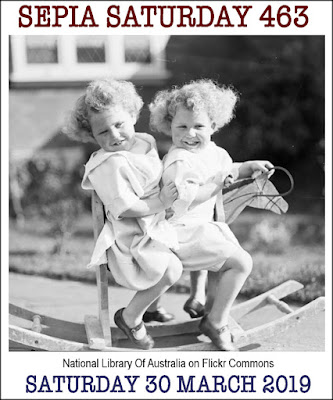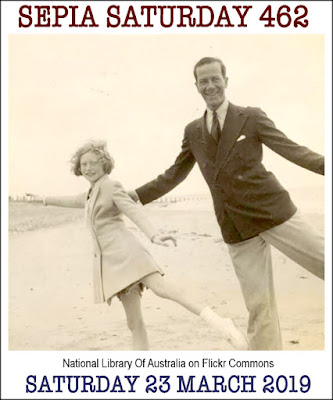Every parent likes to think their child is remarkable.
And parents of twins might be forgiven if their pride is doubled.
And parents of twins might be forgiven if their pride is doubled.
But what exceptional talent could these
two toddlers possibly have, cute as they are,
that would inspire this caption to their photo postcard?
Mr. & Mrs. Jan Kubelik & The Famous Twins.

Mother and father are seated outside on a large manicured lawn with two wide-eyed little girls between them. The girls look about the age of 3. The postcard was published by the Rapid Photo E.C. of London and sent to a wonderfully euphonic name – Miss S. Sharphouse of Victoria Avenue, Thirsk in North Yorkshire. There is no stamp or postmark, but written on the message side is a date and place.
11 Aug 1907
West End Pier
Morecambe
West End Pier
Morecambe
The West End Pier was an amusement promenade in Morecambe, Lancashire that extended over 1800 feet into Morecambe Bay on the Irish Sea. It first opened in 1896 so was then only 11 years in operation when someone penned this note. As it's not a residential address but instead a place of music hall performances, the writer may be an entertainer of some kind. Or maybe just the location for an invitation to meet.
The handsome father and beautiful mother
appeared on another postcard,
but in a younger image
and so without children.
appeared on another postcard,
but in a younger image
and so without children.
This postcard, published by Rotary Photo E.C., is captioned:
Mr. and Mrs. Jan Kubelik
Countess Czaky-Szell
Countess Czaky-Szell
The couple are again outdoors, the husband standing with a dark faraway gaze while his wife is seated, a picture of Edwardian leisure.
_ _ _
This card was sent on September 18, 1907 from Brighton, another city noted for its amusement piers, to Miss Orme, of Boscombe House, Boscombe Avenue, Leyton, Essex
Lovely day. Now
off to Worthing
Hope you likedlittle
photo.
Dudley.
18/9/07
off to Worthing
Hope you likedlittle
photo.
Dudley.
18/9/07
Clearly even without their famous twins, Mr. and Mrs. Jan Kubelik were considered celebrities worthy of having their own postcard series. But who were they? Why were their children "famous"?
Because in 1907 it actually would have been hard to find anyone who didn't recognize the handsome dark eyes and wavy black hair of Jan Kubelik, the brilliant Czech violinist who dazzled audiences everywhere with his music in the first decade of the 20th century. His picture was in every newspaper and music magazine. It was the mark of a good publicist that could secure such cleaver exposure on postcards. What young lady could resist looking into those eyes?
This postcard shows Jan staring into the camera lens and cradling his Guarneri del Gesù (or maybe Stradivarius) violin. It is captioned simply
KUBELIK
Underneath is a date 19-4-03
Jan Kubelik would then have been just age 22. Born on July 5, 1880 in a district of Prague, Jan Kubelik was the son a Czech gardener and amateur violinist. When Jan was just five, his father recognized his musical gift and arranged for violin lessons. By the age of eight he was studying at the Prague Conservatory where he developed phenomenal skill on the violin by practicing 10 to 12 hours a day, or so he said "until his fingers started to bleed." By 1898 at age 18 Jan undertook his first concert tour as a violin soloist. His first tour of the United States in 1900 earned a reported $100,000. In the 1901-02 season he played London to great acclaim, winning a gold medal from the Royal Philharmonic Society. By 1906 he reached Australia.
Kubelik's postcard was mailed on April 19, 1903 to Miss H. E. Godfrey of 16 Snill Road, Kettering. The postmark happened to be just a few weeks after newspapers around the world announced Kubelik's engagement to the Countess Anna Julie Marie Széll von Bessenyö, a romance with the plot line of a romance novel.
 |
| Frederick MD News 21 March 1903 |
In 1900 following one of his concerts in Hungary, Jan Kubelik fell in love with the beautiful daughter of the president of the Hungarian Senate, Wolfgang von Szell. Unfortunately the young woman was betrothed to a Count Czaky and compelled to marry him. However her heart was for Jan and she soon sought a divorce from the count. In the early newspaper accounts of 1903 it was reported that Countess Marianna was a widow, but in later reports from 1915 it seems they received a special annulment from the Pope. In any case Jan and Marianna's love prevailed and by 1904 the Kubeliks had twin daughters, Mary and Anne.
The Kubelik family made their home in a grand castle in Bohemia. I suspect this is where the first two outdoor postcards photos were taken. Even the citizens of Amarillo, Texas could admire the Kubelik estate as pictured in their local newspaper, though as grand as it may have been, I doubt the great violinist ever had an alarm clock like the Russian Czar. Only the highest level of royalty could afford to have a pair of military bandsmen assigned to play helicon duets as a wake-up call every morning.
 |
| Amarillo TX Weekly Herald 28 November 1907 |
By 1907 Mrs. Kubelik had added two more daughters to the family and brought them along when her husband made another concert tour of America that year. In Chicago when questioned about any future matrimonial plans for her two twins, Mary and Anne, Mrs Kubelik said that she thought it a good idea that the girls marry the two twin sons of Fritz Kneisel, a Romanian violinist who was then concertmaster of the Boston Symphony and a good friend of her husband, Jan.
 |
| Spokane WA Press 29 November 1907 |
The Kubeliks eventually would have 8 children, five daughters and three sons. Despite the twins being "famous" it was surprisingly hard to discover the names of the two girls, or for that matter, most of the other children too. Fortunately some newspaper reports did include first names. Some of the five girls became accomplished violinists but only one son, conductor Rafael Kubelík, (1914-1996) would make a career in music that rivaled his father's. Rafael Kubelik was music director of the Chicago Symphony Orchestra; the Royal Opera, Covent Garden; and the Bavarian Radio Symphony Orchestra as well as a frequent guest conductor of orchestras around the world.
Jan Kubelík died in Prague at age 60 in 1940. He was one of the first violinists to achieve success with making early gramophone recordings. YouTube offers this 1911 example of Kubelik's sound which I think is an appropriate piece for a father of eight children, two of whom were "famous twins". It's entitled Perpetuum Mobile by Niccolò Paganini, (1782-1840), who was considered the greatest violinist of his time and the composer of some of the most challenging music for violin. His music was a specialty of Jan Kubelik.
###
###

This is my contribution to Sepia Saturday
where two is always double the fun.
where two is always double the fun.


















































